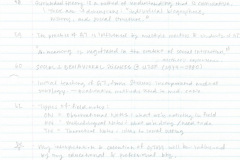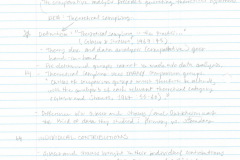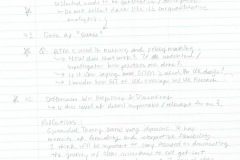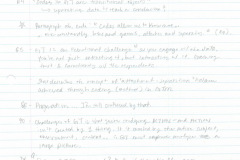
April 22, 2020
- Outcomes from scientific studies are often inaccessible
- What remains invisible in scientific analyses are the invisible relations/infrastructure that allows their practice to occur; part of the “relational world”
- This chapter focuses on Star answering, “how does it feel to do grounded theory?”
- It seems like everyone has their own experience of GT because it’s very personal. Is that true?
- Star feels “intense emotion while doing analysis”
- Our feelings towards GTM will influence the research and comparative analyses process
- Star wanted to “[understand] the world that [she] could carry with dignity in [her] world as a feminist activist and as a working poet.”
- Using GTM seems like such a personal manifesto…. is that how I should approach mine too? With great personal attachment?
A Pathway to Grounded Theory
- Star sought translations between philosophy and social science (in her PhD)
- The Discovery of Grounded Theory was “a manifesto for freedom from the sterile methods that permeated social sciences at the time.”
- Personal Construct Theory by George Kelly (1955, 1963)
- Situational analysis is another methodology; 2nd gen. after Straussian GT (Clarke, 2005)
- What made GT stand out was the involvement of field work
- There are politics to qualitative/quantitative research; faculty favours one or the other; is that still so today? Is that so at iSchool? Can you have the best of both?
- Building an “intellectual infrastructure” is a way to practice doing GTM (as a quick exercise); do it on yourself, on your journey of how you got to where you are now
GT is an excellent tool for understanding invisible things… includes work in the acquisition and practice of method”
Page 79
Code: Getting to “Out of Bounds”
- Code = “sets up relationship with your data, and with your respondents”
- Code = abstractions = “drop away properties from the original object”
- Coding = “a new way of seeing that is more abstract than before” which allows you to catch insights, patterns, capture emotional qualities, compare abstract things that normally cannot be compared
- Coding is like adding a common denominator to things for comparison
Resources
- Kathy Charmaz (2006) Constructing Grounded Theory: A practical guide through qualitative analysis provides clear suggestions, especially on coding
- Adele Clarke (2005) Situational Analysis is a good resource when studying/analyzing disciplinary growth and change; something relevant for my study
A Recipe for the Cognitive-Emotional Generation of a “Code” in Grounded Theory
- Code is an “attachment and separation”
- “Codes in GT are transitional objects”; separating data to research a desired conclusion
Codes allow us to know more about the field we study, yet carry the abstraction of the new. When this process is repeated many times, and constantly compared across spaces and across data, it is also possible reflexively to grow. In grounded theory, this is known as theoretical sampling. Codes are part, also, of the third space of developing, the ‘holding space’ of experience. Theoretical sampling stretches the codes, forcing other sorts of knowledge of the object. The theory that develops repeats the attachment-separation cycle, but in this sense taking a code and moving it through the data. In so doing, it fractures both code and data.
Page 84
- GT is an “emotional challenge” as you engage with the data You’re not just extracting it, but interacting with it. Therefore, the researcher needs to gain trust and familiarity with the respondents / data
- Star describes the concept of “attachment-separation” is balanced through coding method in GTM
- Pragmatism? How does that fit into all of this? I’m still confused by that.
Challenges of GT is that you’re studying ACTION, which isn’t created by one thing. It is created by the active subject, environment, context…Therefore, GT must analyze a large picture; not just a single cause
Does GTM ever end? Theoretically, does it go on forever? How do you know when to stop and when to continue?






